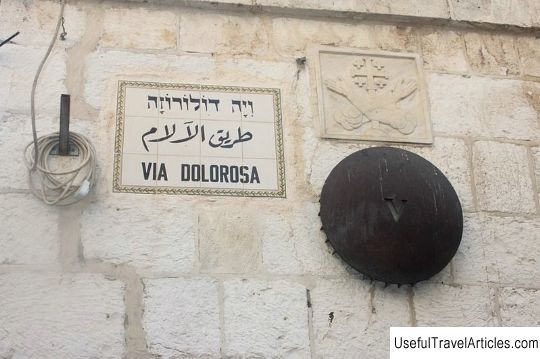Via Dolorosa description and photos - Israel: Jerusalem
Rating: 9,2/10 (1490 votes) 
Via Dolorosa description and photos - Israel: Jerusalem. Detailed information about the attraction. Description, photographs and a map showing the nearest significant objects. The title in English is Via Dolorosa. Photo and descriptionVia Dolorosa, "The Way of Sorrow" is an extremely important street for Christians in Jerusalem. According to tradition, it was along this path that Christ carried His cross to the place of crucifixion. The Way of the Cross begins behind the Lion's Gate. It is known that, having destroyed Jerusalem in the 1st century, the Romans built the city of Aelia Capitolina on the ruins. The present-day Via Dolorosa, part of its main street, hardly corresponds exactly to the real last path of Christ. But, in addition to the geographical, the Way of the Cross has another dimension - the spiritual. In the Catholic Church during Great Lent, the services of the Way of the Cross are held, giving the faithful the opportunity to relive the sufferings of Jesus anew and very personally. Usually in temples there are fourteen images corresponding to the events of the Way of the Cross. They kneel beside them, doing the so-called standing. On Via Dolorosa, the stands are marked with black round signs with Roman numerals, there are nine of them on the street. The first station is not far from the Lion's Gate, near the Al-Omariyah school. It is believed that there was a praetorium where Pilate tried and delivered Jesus to be crucified. Archaeological excavations show that the praetorium was actually located elsewhere, south of the Jaffa Gate. However, this is where the tradition begins the Path of Sorrow, which is six hundred meters long. Across the road is the second station. Here the Savior took on His shoulders a heavy wooden cross. In the Church of the Scourging of the nearby Franciscan monastery, there are stained-glass windows on which - Pilate washing his hands, the scourging of Jesus and crowning him with a crown of thorns, the jubilation of the pardoned robber Barabbas. The third station, at the corner of El Wad Street, commemorates the place where Jesus first fell under the weight of the cross. In a tiny Armenian Catholic chapel of the 15th century, there is a fresco depicting Christ stumbling and angels praying for Him. The Scriptures say nothing about the fall of Christ during the Way of the Cross. However, tradition dictates: there were three of them, all of them are marked on the Via Dolorosa (third, seventh, ninth station). Tradition, however, indicates the places where Jesus met His mother Mary (fourth station) and with St. Veronica, who wiped His face with a silk handkerchief (sixth). But the meeting with Simon Cyrene, who bore the cross instead of Christ (the fifth station), is an event mentioned in the Gospel of Luke. As well as the Savior's appeal to the women of Jerusalem: "Daughters of Jerusalem, do not weep for me ..." (Luke 23:28) - this is the eighth station. The rest of the stands are on the territory of the Church of the Holy Sepulcher: the tenth (Jesus is stripped of his clothes), the eleventh (nailed to the cross), the twelfth (the Savior dies on the cross), the thirteenth (Jesus is removed from the cross) and the last, fourteenth (Christ is placed in the tomb). Today's Via Dolorosa bears little resemblance to a place of concentration and prayer: cries of sellers rush from the street shops, crowded, noisy. But this is exactly the picture that Christ should have seen walking to execution through the seething Jerusalem streets. In the pavement of Via Dolorosa, there are several stone slabs, probably worn out by the sandals of Roman soldiers. One can imagine that the Savior's bloody feet walked on them.        We also recommend reading Cathedral of the Transfiguration of the Savior description and photos - Belarus: Slonim Topic: Via Dolorosa description and photos - Israel: Jerusalem. |




